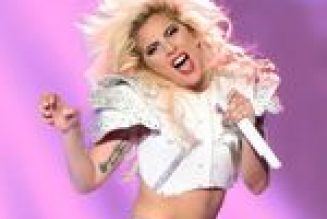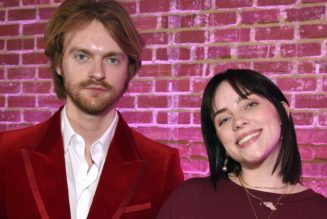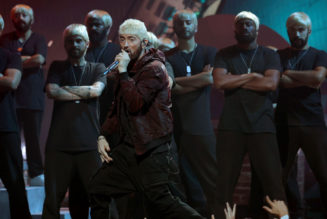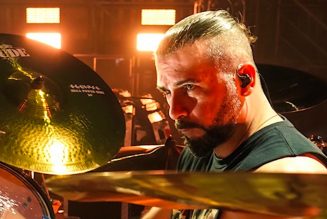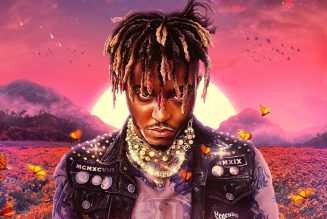By Nicole Briese
It’s been 23 months since the chain-link gates of Lollapalooza last opened to concert-goers in Chicago’s Grant Park, and festival cofounder Perry Farrell is feeling just like the rest of us about the return of live music: cautiously excited. “I want to party, to put it simply,” Farrell tells MTV News on a July afternoon. “We’re getting through this together, but it’s been very difficult.”
His remarks follow the world’s worst pandemic in more than 100 years, which turned the live-music scene upside down in 2020. Farrell’s annual event, which began as a traveling showcase in the 1990s and relaunched in Chicago after partnering with Texas-based company C3 Presents in 2005, was forced to broadcast online. “I want to party, man, I need to,” Farrell laments. “We all need to, we need to celebrate life, because every moment is fleeting. That’s how I’m feeling.”
He’ll soon have his chance. This weekend, Lollapalooza 2021 will open its gates to the public once more with a slew of new safety measures in place. Yet it’s far from business as usual for the festival that garnered 400,000 visitors in 2019 alone. Its reopening on July 29 marks more than the first major multi-genre music gathering to take place in the United States in the wake of COVID-19. There’s another major milestone at play here, as well — the festival’s thirtieth anniversary.
It was never supposed to last three decades. As the story goes, Lollapalooza, the lovechild of Perry Farrell, music executive Marc Geiger, and booking agent Don Muller, actually started out in 1991 as a farewell tour for a band on the brink of implosion — Farrell’s own Jane’s Addiction. “I had no idea what it would become, I just knew that I was having fun,” Farrell, the group’s frontman, says. “I tend to look in front of me. Sometimes I look behind me, [but] very seldom do I look down at my own feet.”
The formula was simple enough: Like Woodstock and other popular music fests that had come before it, Lollapalooza, inspired by the British Reading Festival that Farrell and his bandmates attended, would be headed up by multiple acts on different stages. Unlike other North American festivals, however, which were few and far between at the time, the bands would all travel as a group, with stops in 20 cities along the way.
The largely alternative lineup was a novelty on the music scene at the time. “It wasn’t just a collection of bands, but it also had a mindset, and it had a spirit to it, with activism involved,” explains Nine Inch Nails’s Trent Reznor, who played on the event’s first bill. “It felt like it had a purpose to it.”
The request to join the now-iconic group of initial headlining acts, which also consisted of Rollins Band, Butthole Surfers, Siouxsie and the Banshees, Ice-T, Living Colour, Violent Femmes, Fishbone, and of course, Jane’s Addiction, proved irresistible to the future Oscar winner. “Jane’s Addiction was one of our favorite bands, and at that time, probably the favorite band,” Reznor tells us. “When we got the call to say that Perry had leveraged the success that he had to put on an alternative traveling festival, you know, we didn’t have to think at all for that.”
The experience marked his first foray into previously uncharted territory. “Lollapalooza would’ve been the first festival I’d ever attended, ‘cause I don’t think there’d ever been one that appealed to me,” Reznor shares. “There weren’t a lot of festivals with Depeche Mode on [them], and bands like that that I cared about. Musically, it felt like, hey, here’s a new home for people that couldn’t do something like this before, ‘cause it didn’t exist.”
 Ebet Roberts/Getty Images
Ebet Roberts/Getty ImagesNine Inch Nails performing at Lollapalooza in 1991.
Festival-goers responded in droves. “In those days, people were always interested in the new groups coming up, even if they weren’t even signed yet,” Farrell says.
The first show kicked off in Tempe, Arizona, on July 18, 1991, and its diverse roster of talent brought an energy to the stage that couldn’t be replicated by the arena tours of the era with acts such as Nelson, The Scorpions, and Winger. “I’ll be honest — there was a precognitive at the time, and I’m thinking right now of watching Gibby Haynes [of the Butthole Surfers] blow off his shotgun over the crowd. I just thought, ‘Wow, man,’” Farrell recalls of the infamous 1991 moment when Haynes first fired a series of blank shells over shocked concert-goers’ heads.
Haynes’s onstage antics would be repeated many times throughout the tour. “It was a 12-gauge shotgun, and I discharged it perhaps 12 times per show … for the entire summer,” he clarifies. As the “Pepper” singer explains, the blasts were a way to replace the normal stage effects the band typically incorporated into its shows in the dark. It also served as a metaphor for Butthole Surfers itself: “It’s just loud, threatening, and scary.”
It was also something new and different. At the time, Perry says, record companies aimed for tours dedicated to “like, stadium rock, and it wasn’t quite working out. It was kind of stale, you know? Watching everybody just let loose at Lollapalooza…,” he trails off. “You know when your parents would go off on a vacation, but they wouldn’t take you, so that you were left and you would throw your house party? It felt just like that.”
More than simply disrupting the status quo, though, the experience signified a changing of the guard for the music industry. “It felt like revolution was in the air,” Reznor remembers. “There were a lot of bands doing things that weren’t mainstream. They weren’t really being played on the radio, but there was a lot of music that felt exciting that kind of fell just outside of that.”
The event faced its challenges, to be sure: Fights erupted both onstage and off, namely, as Farrell has said, between him and guitarist Dave Navarro. Unexpected malfunctions also arose. “Our equipment was … duct tape and homemade cases,” Reznor recalls. “It wasn’t pro-level gear we were touring with. And I look, and there’s Living Colour, and they’ve got … shit that looks like Guitar Center racks, put together properly, professional job, stenciled logos on the side of their … they had cases!” he says. “I thought, man, we don’t have our shit together. We didn’t have any money, but we didn’t know any better.”
The band got a fast education when their cables — one gifted to a 16-year-old Reznor by his father — began to melt in the over 100-degree Arizona sun. “You had to laugh, ‘cause what else could you do?” he says. “We blew it the first 10 minutes we were out there! Though it did force us to go out and buy some new cables.”
That wasn’t all that took a beating on the NIN stage. “I never knew you could throw a DX7 synthesizer,” Haynes says with a laugh. “[Trent] would, like, jump on it and throw [it]. Their road crew figured out how you could take pieces from a broken one and assemble another one. They had, like, a Pick-n-Pull for synthesizers there.”
Amid all the chaos, something else was born: an unbridled, feral energy that could no longer be contained — and an unbreakable bond between the headlining acts. “Everybody became friends over the whole summer,” Haynes says. “At the end of it, everybody wanted it to keep going. It was really sad when it was over.”
 Steve Eichner/WireImage/Getty Images
Steve Eichner/WireImage/Getty ImagesButthole Surfers performing at Lollapalooza in 1991.
There would be many more iconic moments to follow over the years. There was 1992, when Eddie Vedder made his infamous lighting-truss climb before diving into the crowd. 1994, when a newly widowed Courtney Love dove headfirst into the crowd following a set. 2003, when Steve-O was arrested for, as he later recounted, “pulling out [his] penis and peeing on potato chips.” 2015, when Travis Scott instructed fans to storm the stage. Farrell’s own personal favorite was seeing Lady Gaga stage dive twice during her 2010 set with Semi Precious Weapons.
“Lady Gaga showed up in, like, a see-through bodysuit? And went and stage dived in the crowd at one of the small stages, and they were just ripping [at] her limbs,” Farrell says. “She looked like Mary Queen of Scots, [who] was beheaded, right? But she was enjoying herself. We did pull her up, and then she turned around and jumped back in. It’s so fucking cool, and it makes me like her a lot. I thought that was very bold and very big of her.”
Those seemingly once-in-a-lifetime occurrences served as the driving forces for the near-instantaneous commercial success of the festival and its participants. “I look back at that as a real turning point of Nine Inch Nails breaking through to some degree,” Reznor says. “The level of audience increased significantly after those shows. It was a homemade, low-budget operation, and we got up to Lollapalooza, now we’re playing real, professional venues.”
“Nine Inch Nails blew up so big in the middle of that middle of that tour,” Haynes remembers. “They are the ones that got the crowd started. The crowds went apeshit for them. It was on after that.”
Farrell, for his part, had spent a lifetime priming for success in his new role as a festival producer. Long before he was belting out hits such as “Jane Says” and “Been Caught Stealing,” he was creating experiences for others as a vocalist and hype man for his first band, Psi Com. “We started putting on our own parties, because we didn’t feel like we could fit in at Gazzarri’s,” he recalls of the famous hair-metal joint that reigned on the Sunset Strip through the early ‘90s. “We knew we weren’t welcome, so we put together our own damn party.”
The singer even personally printed up the tickets to his events. “Literally, we would be on the streets like Hare Krishna guys, except we’d be handing out handbills to people to go and see our show.” The more he took on, the more he learned. “Your circle of influence starts to widen and widen and widen, like when you drop a pebble — or an atom bomb — into the water.”
Those early lessons later allowed Farrell to bring the festival back to life after sales began to plummet circa 1997. “At that time, there were probably four or five other festivals, and it diluted our strength,” he explains. With not enough headlining acts to go around, the decision was made to cancel the 1998 event. By 2003, Jane’s Addiction had not only reunited, but released its third studio album, Strays, produced by classic-rock legend Bob Ezrin (Kiss’s Destroyer, Pink Floyd’s The Wall). Farrell was then keeping company with modern rock gods Tom Morello, of Rage Against the Machine, and late Soundgarden and Audioslave frontman Chris Cornell, when he had an epiphany. “Right now, what’s going on in the world is people are starting to play video games,” he recalls thinking, “and I just kind of saw, oh man, we could do a Lollapalooza, bring in video gaming, and … talk about alternative energy. I kind of got hot, so I just kinda lit a match. And then, it lit up again.”
 Paul Natkin/Getty Images
Paul Natkin/Getty ImagesA reunited Jane’s Addiction performing at Lollapalooza in 2003.
Tapping his bandmates and friends as headliners, Farrell’s Lollapalooza was reborn as a traveling tour for the very last time. 2004 once again saw soft ticket sales, and in 2005, he, along with his partners at the William Morris Agency, made the decision to bring in an outside production company in C3 Presents. Together, they brought the festival back from the grave once more, this time as a destination festival in Chicago. To Farrell, it was the perfect choice for the event’s rebirth. “It reminds me of America a lot. There are good people, and they are different colors, shapes, sizes, sexual proclivities and … studies of theology. They’re just, like, a hodgepodge of interesting people.”
The new, committed location was just the tip of the iceberg. With fresh faces at the helm of the ship, Lollapalooza’s once alternative lineup was quickly expanding into other musical categories, with electronic-heavy acts like M83 and indie darlings like Death Cab for Cutie and Tegan and Sara appearing on the bill. As Farrell shares, however, it had never really been about any one specific genre. “Music is really holy to me. To me, it’s my religion as much as anything else. The sound that you’re bringing to me will either heal me or hurt me.”
The same can be said of the festival scene at large. “I think the work that Perry did here in America, I would imagine that his impact was well-bought by making a tangible festival that’s interesting, that has an identity, that’s also commercially viable, is one of the main reasons in pursuing festivals now,” Reznor says.
From Farrell’s perspective, it’s the melting pot of attendees that makes it all worthwhile. “What is so beautiful is when you see [people] all coming together and enjoying themselves and digging and appreciating each other’s culture, that’s what I get to do. That’s the most that I get out of it. That’s what I love about it.”


